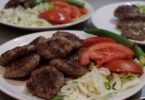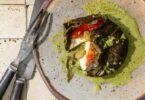Ashwani Kumar
Have you ever heard about Samgyetang? It is a traditional Korean ginseng chicken soup mainly consumed during the scorching summer days to stay healthy. Sipping a warm bowl of this classic dish is the Korean way of fighting back the warmer days with more heat.
With the sun beating down on us and the UAE already recording one of the hottest days this year, this soup could be the right tonic to manage this harsh season.
Recently, Baek Eun Sook, wife of Yoo Jeh Seung, the Ambassador of Korea to the UAE, held a special cooking class to create awareness about the uniqueness of this cuisine. “This is mainly consumed during the three hottest days in Korea. The soup gives you the stamina to stay healthy during summer days,” she told Khaleej Times.
The Korean Embassy and Korean Cultural Centre, UAE, organised the ‘K-Food Cooking Class’ for spouses of ambassadors and diplomats at Taon, a Korean restaurant in Abu Dhabi’s Sofitel Hotel. The aim was to promote highly nutritional food among other communities, who can then cook and enjoy the benefits of this soup with medicinal herbs.
A look back at history

There are three hottest days in Korea, which this year fall on July 11 (Chobok) and 21 (Jungbok), and August 10 (Malbok), and are called ‘Sambok’ or ‘Boknal’.
According to the record of Korean Seasonal Customs, published in 1849, the concept of ‘Sambok’ or ‘Boknal’, was introduced to Korea from China during the Qin dynasty (221BC-206BC).
Historically, Koreans have associated ‘Sambok’ or ‘Boknal’ with the custom of eating hearty soups. It is believed that this helps to balance the body’s temperature, regain energy and relieve exhaustion, keeping them healthy during the sweltering and humid Korean summers. And over the years, Samgyetang has gained popularity globally.
Knowing all about Samgyetang

‘Sam’ means ginseng – the herb with numerous health benefits, ‘gye’ is a Korean word for chicken and ‘tang’ is soup. It is often regarded as a quintessential summer dish, and combines digestible and nutrient-rich chicken meat with the medicinal properties of ginseng, known as a panacea for its healing effects. By harmonising these ingredients, Samgyetang swiftly restores vitality, which can easily be depleted in the summer season.
Originally named Gyesamtang, it was later called Samgyetang due to the value attributed to ginseng as a supporting ingredient. This dish exemplifies the traditional Korean concept of ‘yakshik-dongwon’ – the idea that medicine and food share the same origins.


The history of Samgyetang dates back to the Japanese colonial era when affluent households began incorporating ginseng into their chicken soups. However, it was not until the 1960s and further popularisation in the 1970s that Samgyetang took on its recognisable form.
Over time, Samgyetang has evolved into a diverse and elaborate dish. Variations such as Hanbang Samgyetang incorporate a range of medicinal herbs like nokak – or a deer horn, chestnuts, and angelica root, while Haemul Samgyetang introduces ingredients like natural abalone and octopus for added flavour.


In modern times, instant Samgyetang has gained popularity, offering a convenient solution for those seeking a quick and satisfying meal. By simply heating it in boiling water, this easily accessible option has become particularly favoured among contemporary individuals.
Samgyetang, with its warm and invigorating properties, not only provides relief from the sweltering heat but also rejuvenates tired bodies. Its efficacy in boosting vitality during the scorching summer months has solidified its position as a timeless and representative health food in Korean cuisine.
How to prepare Samgyetang?

Ingredients: young chicken, short grain sweet rice or glutinous rice (1/2 cup), dried or fresh ginseng (one), whole garlic cloves (5-6), dried jujubes (5-6 red dates), green onion (2) and white onion (1/2), water (1.5-2 litres) and salt, and herbs pack including milk vetch root, wild mulberry tree, acanthopanax, licorice and dong quai. The kit is available in stores.
Wash the glutinous rice and soak it for 30-40 minutes in water. Clean the chicken, remove the fat, and then stuff its stomach with soaked glutinous rice, garlic cloves, ginseng, and jujube. Tie the legs in a cross format to ensure the rice and stuffing remains inside while it’s cooked in a pot. Now, add the rest of the ingredients from the herbal pack. Mix a little salt as per requirement, and boil it.

When it starts to boil, lower the flame to medium-low and let it simmer for about 30 minutes for the flavours to meld together. The ginseng-flavoured chicken will be tender, tasty, and the broth nutritious. Now, place it in a bowl and garnish with dates or green onion. The overall preparation time is 90 minutes.
“This is very nutritious soup,” said Hyeri Hwang, the owner of Taon restaurant.
Kyusik Kong, the chef who prepared the dish, added: “You may sweat while having the soup, but soon you will start to like and enjoy it.”
Participants during the event included spouses of ambassadors and diplomats from missions of Tuvalu, France, Belgium, Thailand, Canada, Finland, Vietnam, Afghanistan, the US and Sweden.







